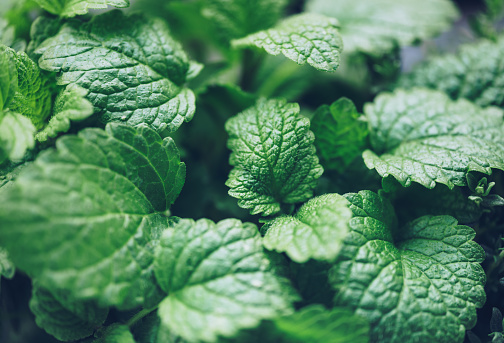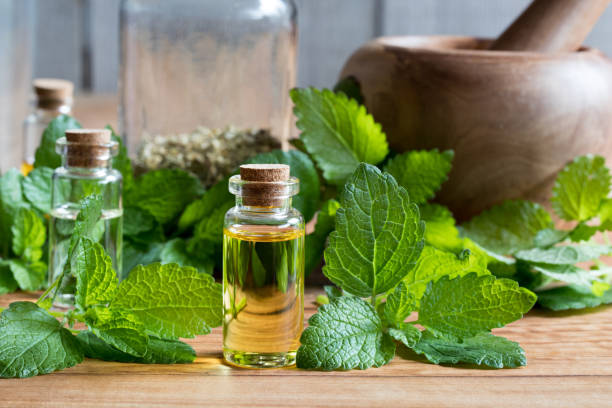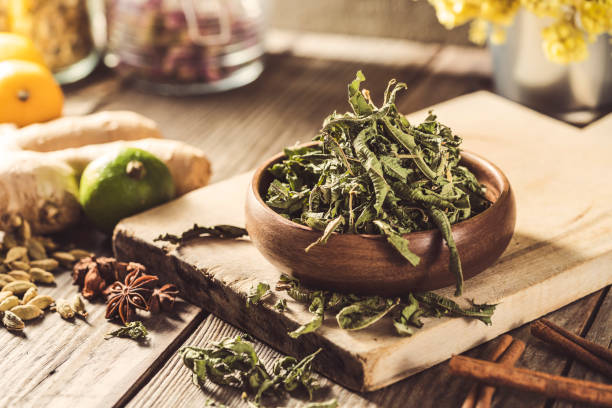Lemon Balm (West Coast USA, Germany, Europe)
Balm (East Coast, India, China)
(Melissa officinalis)
Lemon Balm; A Honey of a Healer – Bacteria fighter (streptococci and mycobacteria); pain relief for wounds; helps fight mumps, herpes, and other viruses; a natural tranquilizer; digestive aid; menstrual cramps.
Warning: Two recent studies show that balm interferes with the thyroid-stimulating hormone, thyrotropin. There are no reports of this herb causing thyroid problems, but anyone with a thyroid condition should discuss balm's thyrotropin-inhibiting effect with a physician before using it.
—Botanical name— Melissa officinalis
—Description— Wound treatment, Herpes and other viral infections, A Natural tranquilizer, Digestive and Women's health.
—Family— Labiatae; other members include mint.
—Synonyms— Lemon balm, bee balm, Melissa, sweet balm, and cure-all.
—Parts Used— Leaves.
—Constituents— Polyphenols, eugenol.
—Medicinal Action and Uses—
Contemporary herbalists tout balm's traditional uses: It's stilled used to induce sweat and menstruation and is recommended to treat headache, flatulence, hypertension, stress, bronchitis, indigestion asthma, and infant colic. Modern science has not supported all of balm's traditional uses – it has been abandoned the 19th century notion that balm is a stimulant, and Culpeper was off base by saying it “opens obstructions in the brain.” But studies show this herb may have even greater healing potential. #
WOUND TREATMENT – Score one for Dioscorides. Balm contains chemicals (polyphenols) that may help fight several infection-causing bacteria, among them Streptococci and mycobacteria. Balm also contains eugenol, an anesthetic that may help relieve wound pain.
HERPES AND OTHER VIRAL INFECTIONS – Balm helps fight mumps, herpes, and other viruses. American pharmaceutical companies have ignored balm's possible antiviral action, but Europeans have not. In Germany, where herbal medicine is more mainstream than it is in the United States, balm extract is an active ingredient in Lomaherpan Crème, an ointment used to treat cold sores and genital herpes. Unfortunately, this product is not available in the United States.
A NATURAL TRANQUILIZER – Researchers have discovered that balm oil – the source of the plant's pleasant fragrance – may have tranquilizing properties, supporting the herb's traditional use as a relaxant. In Germany, balm is widely used as a tranquilizer and sedative.
DIGESTIVE AIDE – German researchers have discovered that balm relaxes the smooth muscle tissue of the digestive tract, thus supporting its age old use as a digestive aid.
WOMEN'S HEALTH – Herbs that relax the digestive tract may also calm another smooth muscle, the uterus. This potential effect could help support balm's traditional use in treating menstrual cramps. However, balm has also been historically recommended as a uterine stimulant to promote menstruation. No contemporary research clarifies this confusing situation. For this reason, pregnant women should not use it. Other women might try it to begin menstruation.
—Nutrient Source—
—Side Effects or Negative Effects— Two recent studies show that balm interferes with the thyroid stimulating hormone, thyrotropin. There are no reports of this herb causing thyroid problems but anyone with a thyroid condition should discuss balm's thyroid-inhibiting effect with a physician before using it.
Balm is on the Food and Drug Administration's list of herbs generally regarded as safe. The medical literature contains no reports of toxicity. For otherwise healthy non-pregnant, non-nursing adults who do not have thyroid conditions, balm is considered safe in amounts typically recommended.
Balm should be used in medicinal amounts only in consultation with your doctor. If balm causes minor discomfort, such as stomach upset or diarrhea, take less or stop using it. Let your doctor know if you experience any unpleasant effects or if the symptoms for which the herb is being used do not improve significantly in two weeks.



—References— A Modern Herbal – https://botanical.com/botanical/mgmh/comindx.html
—References— “Advanced Treatise in Herbology” by – Edward E. Shook, N.D., D.C. Copyright by Wendell W. Whitman 302 E. Winona Avenue, Warsaw, IN 46580.
—References— Business Dictionare.com http://www.businessdictionary.com/definition/anaerobic.html
—References— Chelidonium majus – an Integrative Review : Traditional Knowledge versus Findings; Chelidonium majus – an Integrative Review: Traditional Knowledge versus Modern Findings
—References— “Dicitionary.com” http://www.dictionary.com
—References— “From the Shepherd's Purse” by – Max G. Barlow, Copyright 1990, ISBN 0-9602812-0-7.
—References— Handbook of Medicinal Herbs second edition By James A. Duke with Mary Jo Bogenschutz-Godwin, Judi duCellier, Peggy-Ann K. Duke
—References— “Healing Herbal Teas” A Complete Guide to Making Delicious, Healthful Beverages. By – Brigitte Mars, A.H.G. ISBN – 13: 978-59120-110-6 and ISBN – 10: 1-59120-110-1 Copyright 2006
—References— Henriette's Herbal Home – https://www.henriettes-herb.com/faqs/index.html
—References— “Herbal Medicine – The Natural way to Get Well and Stay Well” by – Dian Dincin Buchman, PhD, Copyright 1979, 1996, ISBN: 0-517-14767-x, Page 2, 14-17, 31, 121, 139, 145-146, 162, 165, 168, 190, 192, 193, 202, 206, 252
—Reference— Herbs & Natural Supplements An evidence-base guide Volume 2; By Lesley Braun and Marc Cohen.
—Reference— Indian Spring Herbal Encyclopedia by Natalie Awanata Lapahie
—References— Medicine Net.com http://www.medterms.com
—References— Medical Herbalism The Science and practice of herbal medicine by David Hoffman, FNIMH, AHG, Copyright 2003, ISBN – 0-89281-749-6
—References— “Nutritional Herbology” by – Mark Pedersen, Copyright 2008, ISBN – 10: 1-885653-07-7; ISBN – 13: 978-1-885653-07-9
—References— Planetary Herbology by – Michael Tierra, C.A., N.D., Copyright 1988, ISBN – 0-941524-27-2
—References— “Prescription for Nutrition Healing” by – Phyllis A. Balch, CNC, Copyright 2006, ISBN: 1-58333-236-7.
—References— Principles and Practices of Phytochemistry
—References— The Book of Herbal Wisdom
—References— The Encyclopedia of Herbs – A Comprehensive Reference to Herbs of Flavor and Fragrance -By Arthur O. Tucker and Thomas Debaggio.
—References— Encyclopedia of Medicine By Andrew Chevallier FNIMH
—References— The Essential Guide to Herbal Safety
—References— The Healing Herbs – The Ultimate Guide to the Curative Power of Nature's Medicines” by – Michael Castleman; Copyright 1991; ISBN: 0-87857-934-6; Page: 72 – 74
—References— “The Ultimate Healing System – The Illustrated Guide to Muscle Testing & Nutrition” by – Donald Lepore, N.D. Copyright 1985, ISBN: 0-94717-11560-7.
—References— WebMD http://www.webmd.com/default.htm
—References— Wikipedia The Free Encyclopedia.com http://en.wikipedia.org/wiki/Main_Page
Note: Information and statements about the products on this Book and/or PDF file, have not been evaluated by the Food and Drug Administration and are not intended to diagnose, treat, or prevent any disease. You should not use the information contained herein for diagnosing or treating a health problem or disease or prescribing any medication. If you have or suspect that you have a medical problem, promptly contact your health care provider.
Generated on April 29, 2007
Updated on November 12, 2008
Updated on March 24, 2023



